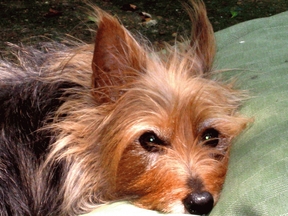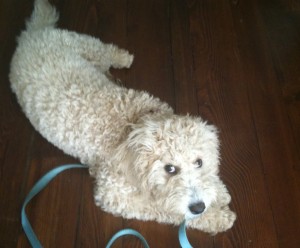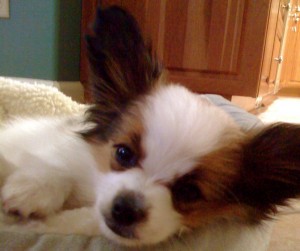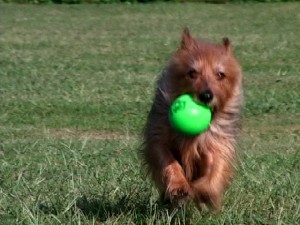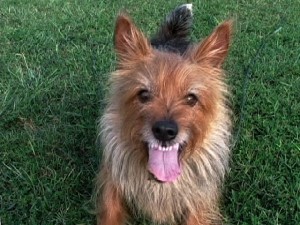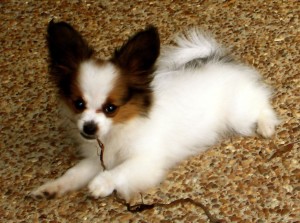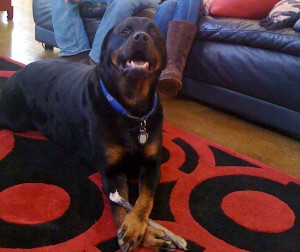 There are many methods to teach down. Before you begin training your dog, you’ll need to learn a bit about communication and motivation. Please visit the Dog Training Start Here Category. There you will learn about markers and rewards, two excellent topics for communicating and motivating! A prerequisite for “stay” is “Attention on Cue”. It doesn’t hurt if your dog already knows “Sit” too!
There are many methods to teach down. Before you begin training your dog, you’ll need to learn a bit about communication and motivation. Please visit the Dog Training Start Here Category. There you will learn about markers and rewards, two excellent topics for communicating and motivating! A prerequisite for “stay” is “Attention on Cue”. It doesn’t hurt if your dog already knows “Sit” too!
Here’s how I use and fade a food lure when teaching down via the lure method. It’s much easier to lure a down from the sit position, so the pup must know sit.
Introduce this (and any new behavior) in a quiet area where you are not competing for your pup’s attention.
Place a few small treats in a dish nearby. Stand in front of your pup. Ask him to sit. Acknowledge the sit with a “thank you” or a smile.
Place a small piece of food in the palm of your open hand. Hold it in place by crossing your thumb over it. Keep your fingers straight. Now, hold your hand with the treat next to your shoulder, palm out – as if you were taking an oath. Say nothing.
Hold your hand in position for about 3 seconds and then place your open palm (with treat) directly in front of your pup’s nose. Say nothing. Slowly move your open hand straight down, being careful not to lose the “connection” between the dog’s nose and the treat. (Your hand should never be more than 2 inches away from your dog’s nose during this step.)
Depending on the dog’s size and your height, you may need to kneel down before you place your hand in front of the dog’s nose.
The dog should move his head down in an effort to follow the treat. Keep moving your hand down, until it is almost to the floor. Right before your hand reaches the floor, move your hand just a wee bit closer to you. This will give the dog space to move his body into the down position without standing up.
When the dog plops his chest down on the floor, mark the instant of success and then release the treat.
Repeat two more times (with a treat in your hand each time) for a total of three trials.
On the fourth trial, do not place a food treat in your hand. Repeat the same sequence of steps. Slowly move your empty hand downward to lure the dog into the down position. Mark the instant of success and then get a treat from the dish. Toss the treat on the floor.
This will keep the dog’s attention focused downward and get him into a standing position, ready for the next trial. Repeat the sequence two more times without a treat in your hand.
Troubleshooting – Lure Down
When luring your dog into the down position, he might stand up. If your dog stands up, it is likely that your hand is too far away or you are not moving it straight down. Your hand should track the natural path that the dog’s head tracks when he lays from the sit position.
Here’s what I do if the dog continues to move out of the sit position, even though I am following the correct path with my hand. I remove my hand the instant the dog moves out of the sit position, and start over from the beginning.
Once your dog will follow your empty hand, it’s time to fade your hand motion.
Start the next exercise immediately after three success followed by a very short play period.
Lure Down – Fading the Hand Motion
Now that your dog has followed your empty hand a few times, you can fade your hand motion and teach the dog that your initial ‘hand-beside-shoulder signal’ is the cue to down. Here’s how I do it.
To warm the dog up, repeat the same sequence as before, without a treat in your hand. Hold your open palm up next to your shoulder as if you were taking an oath. Wait about 3 seconds and then place your hand directly in front of your dog’s nose. Slowly move your open hand straight down, being careful not to lose the “connection” between the dog’s nose and your hand. Your hand should never be more than 2 inches away from your dog’s nose during this step.
The dog will move his head down in an effort to follow your hand. Keep moving your hand down, until it is almost to the floor. Right before your hand reaches the floor, move your hand just a wee bit closer to you. This will give the dog space to move his body into the down position without standing up. When the dog plops his chest down on the floor, mark the instant of success and then get a treat from the dish and pay your dog. Do this two more times for a total of three trials.
On the fourth trial, follow the same sequence- except – instead of 3 seconds; hold your open palm at shoulder level for several seconds and just smile at your dog. Wait quietly. If your dog is looking at you, wait up to 15 seconds. Say nothing. Just smile. Be prepared to mark the instant of success as many dogs will go down within the 15 seconds.
If your dog doesn’t go down within 15 seconds, complete the sequence as before. Try again two more times with the 15 second wait time. Most dogs will “get it” within these three trials.
Troubleshooting – Hand Signal for Down
If your dog averts his attention during the 15 second period, make some soft noise that will reengage his attention right before he starts to fidget. Don’t use words. I usually make kissing or clucking sounds. Be patient.
If your dog doesn’t go down within the 15 second period, follow the same sequence as before. Slowly move your open hand straight down, being careful not to lose the “connection” between the dog’s nose and your hand. The dog should move his head down in an effort to follow your hand.
Keep moving your hand down but stop moving your hand 2 or 3 inches before you get to the floor. Your dog should keep going down. Mark the instant of success and then give your dog a treat from the dish.
Methodically decrease the amount of downward hand motion from trial to trial.
After several trials (or maybe several short sessions with several trials) your dog will go down earlier and earlier during the sequence. Now, the open palm in oath position is your hand signal for down!

